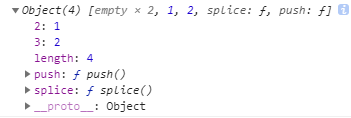js中的类数组对象,它具有数组的下标和length,但是没有数组相关的方法(push、slice、map、、、),现将数组的方法强行给它,会发生什么呢?
var obj = { '2': 3, '3': 4, 'length': 2, 'splice': Array.prototype.splice 'push': Array.prototype.push } console.log(obj) //=> ?
上面代码,强行给这个类数组对象增加一个数组的push方法,先打印一下这个类数组对象:

接下来在类数组对象中使用push方法:
var obj = { '2': 3, '3': 4, 'length': 2, 'splice': Array.prototype.splice, 'push': Array.prototype.push } obj.push(1); obj.push(2); console.log(obj) //=> ?
最后会输出什么呢?

打印obj中的‘2’、‘3’对应的3,4,分别变成1,2了,其主要原因还是push。
在mdn中对push的描述:push() 方法将一个或多个元素添加到数组的末尾,并返回该数组的新长度。
push 是特意设计为通用的,既适用于数组,也适用于对象。正如下面的例子所示,Array.prototype.push 可以在一个对象上工作。 注意,我们没有创建一个数组来存储对象的集合。 相反,我们将该集合存储在对象本身上,并使用在 Array.prototype.push 上使用的 call 来调用该方法,使其认为我们正在处理数组,而它只是像平常一样运作。
var obj = { length: 0, addElem: function addElem (elem) { [].push.call(this, elem); } }; obj.addElem({}); obj.addElem({}); console.log(obj.length); //=> 2
因此可以总结push的原理如下:
Array.prototype.push = function(elem){ this[this.length] = elem; this.length ++; }
回到题目中,obj.push(1)=>obj[2] = 1; //此时obj的length为2
obj.push(2)=>obj[3] = 2; //此时obj的length为3
因此,得到上面的打印结果,由于类数组对象中没有属性为‘0’、‘1’,所以前面会有俩个值为empty。
脚踏实地行,海阔天空飞
分类:
面试题
标签:
JavaScript
, 面试题






【推荐】国内首个AI IDE,深度理解中文开发场景,立即下载体验Trae
【推荐】编程新体验,更懂你的AI,立即体验豆包MarsCode编程助手
【推荐】抖音旗下AI助手豆包,你的智能百科全书,全免费不限次数
【推荐】轻量又高性能的 SSH 工具 IShell:AI 加持,快人一步
· AI与.NET技术实操系列:基于图像分类模型对图像进行分类
· go语言实现终端里的倒计时
· 如何编写易于单元测试的代码
· 10年+ .NET Coder 心语,封装的思维:从隐藏、稳定开始理解其本质意义
· .NET Core 中如何实现缓存的预热?
· 25岁的心里话
· 闲置电脑爆改个人服务器(超详细) #公网映射 #Vmware虚拟网络编辑器
· 零经验选手,Compose 一天开发一款小游戏!
· 因为Apifox不支持离线,我果断选择了Apipost!
· 通过 API 将Deepseek响应流式内容输出到前端